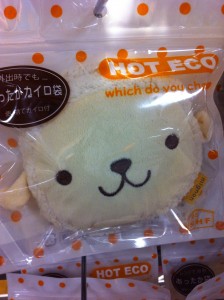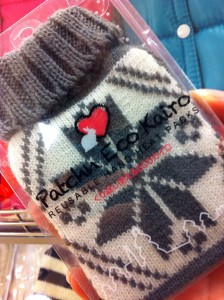Posted by Ashley Thompson (Shizuoka-ken, 2008-2010) of Surviving in Japan: without much Japanese and Lifelines columnist for The Japan Times.
So you’ve prepared your home in Japan as best you can for winter and you’ve got a heater or two, or a kotatsu, to keep you warm. What else can you do to survive the winter in Japan, especially with the continued emphasis on energy conservation?
1. Carry “kairo” (カイロ). Small body (typically hand) warmers. The disposable kind are the ones you open and shake up and typically last a few hours. Some can be placed in your shoes, around your ankles, around your waist or even around your wrists. Here are a few examples.
I’ve also noticed a trend of “eco-kairo” (エコカイロ) this year. The eco-kind vary, but some are filled with gel and you heat them in the microwave. Some are battery-powered (I’m not sure exactly how that is very “eco” though, unless they’re solar-charged, but I suppose it is less wasteful to some degree).
Some examples of “eco kairo” with cute covers (found at Loft):

2. Use a lap blanket. Whether at work or home, these smaller blankets are good to have on hand. Look for ひざかけ (膝掛け).
3. Or a space blanket. They aren’t just the shiny, futuristic looking sheets anymore (though you can get those too). These kind are fabric-covered. Look for スペースケット.
4. Or an electric blanket. Look for 電気毛布 (でんきもうふ, denkimoufu).
5. Use a hot water bottle (湯たんぽ, ゆたんぽ). Especially good for cold feet.
6. Eat hot dishes. Like Nabe. Curry. Ramen. Or any other hot meal. What’s your favorite?
7. Drink lots of hot tea, especially if your workplace provides it for free.
8. Hot drinks. Remember that many vending machines and conveniences stores have a section for “hot drinks” (usually have a red label underneath and say あったかい or “hot drink” while the cold ones have a blue label, and yes, the vending machines that offer them do change over from summer).
When I first arrived in Japan I had no idea you could buy a hot beverage from a vending machine, and when I chose (cold) tea, thinking I was just choosing regular tea from a vending machine, the person I was with looked at me in complete shock.
“Don’t you want a hot drink?” she asked.
“What? There’s hot drinks?”
“Yes.” She points to the red label, “These are hot.” The look accompanying this was more or less, “how did you miss that…”
Not sure if it’s just me, but I never really came across a vending machine in the US with hot drinks aside the dispenser types at some schools or hospitals, etc. Who needs a vending machine with a coffee shop on every street corner? I am from Seattle after all.
9. Heat Tech from Uniqlo. What you would call long underwear. If not from Uniqlo, wool or silk are also great materials (and yes, you can get non-itchy, lightweight wool base layers – merino wool is one of those). If you’re prone to being cold like I am, you’ll be extra thankful for that base layer!
10. Layer. Outer layer. While you’re shopping for long underwear, do yourself a favor and get a warm winter coat. I recommend anything with down. Uniqlo and Muji have them, but here’s a secret, Sierra Trading Post often has crazy discounts on down jackets. (No, they didn’t pay me to say that – I wish). Be careful if you want anything with fur trim though, as customs might get you when you have it shipped here directly.
CLICK HERE to read the other 14 ways.
JET Alum Projects $54.3 Billion in New Law School Debt by 2020
*****
Matt Leichter (matt [dot] leichter [at] gmail [dot] com) (Saitama-ken 2003-05) is a renegade attorney who plays by his own rules. He operates a think tank of one, The Law School Tuition Bubble, where he archives, chronicles, and analyzes the rising cost and declining value of legal education in the United States.
On December 5, the American Lawyer (aka the AmLaw Daily) published Leichter’s most recent article, “Law School Debt Bubble, Part II: Data Show Feds Will Lend $54.3 Billion to U.S. Law Schools by 2020,” in which he uses American Bar Association data to project the exponential growth of law school debt in contrast to the small number of new lawyer jobs in the U.S.
JET Alum Calculates American Law Graduate Debt Grew $475 Million from 2008 to 2010
*****
Matt Leichter (matt [dot] leichter [at] gmail [dot] com) (Saitama-ken 2003-05) is a renegade attorney who plays by his own rules. He operates a think tank of one, The Law School Tuition Bubble, where he archives, chronicles, and analyzes the rising cost and declining value of legal education in the United States.
On November 22, the American Lawyer (aka the AmLaw Daily) published Leichter’s most recent article, “Law School Debt Bubble: Aggregate Law School Grad Debt Grew $475 Million Between 2008 and 2010,” in which he uses U.S. News and World Report and American Bar Association data to illustrate the ever-increasing growth in law school debt graduates have taken on even though law jobs have been disappearing for decades.
Links to Leichter’s previous AmLaw articles can be found here.
Posted by Ashley Thompson (Shizuoka-ken, 2008-2010) of Surviving in Japan: without much Japanese and Lifelines columnist for The Japan Times.
Most homes in Japan aren’t equipped with central heating, so people typically rely on space heaters and similar items. Now, we all know that wearing some extra clothes and warm fleece is a good way to avoid turning the heat all the way up, but most likely you will need (or desperately want) a heater at some point.
And, just to note, I am not an expert on heaters, so if you are curious about how a heater works a certain way, go ahead and google that.
Also, most of the heaters below have timers and auto-turnoff options in addition to running constantly. They also often have automatic shutoff features such as if the heater fell over.
*Keep in mind another way heater might be written is 電気ストーブ (denki stobu).
*The word used for “heating” is 暖房 (だんぼう, danbou).
A guide to heaters in Japan
1. Aircon – エアコン
The air conditioner is commonly known as an aircon in Japan, and most aircons are equipped with a heating function. So, if you have an aircon, you may want to check that out (look for “暖房”). From experience I know it does a pretty good job heating a room, although I found that all the heat rose to the ceiling which was somewhat pointless if you spend most of your time sitting on the floor and don’t have a ceiling fan.
I also found that running the aircon was incredibly expensive. Some are much more energy efficient (look for 省エネ on the outside or description). Aircons are also one of the more expensive options, considering that most will be ¥30,000 – 40,000 and up, depending on the size.
2. Oil heater – オイルヒーター
This heater is the one that looks like a radiator, and some of you may be familiar with already. My family used these when I was a kid, and though they work really well, they are typically energy hogs. Some are better than others though, so it’s best to compare when looking at energy usage. Some of the ones I looked at operate at 1200 watts at the highest level, with an estimated ¥15-20/hour cost to operate (though this varies). Price may range from ¥5,000 – 30,000, though it’s possible to find cheaper options at a recycle shop (this goes for all of the following options as well).
3. Panel heater – パネルヒーター
CLICK HERE to read the rest of the post.
Posted by Ashley Thompson (Shizuoka-ken, 2008-2010) of Surviving in Japan: without much Japanese and Lifelines columnist for The Japan Times.
I wrote Part 1 of this “Giving Birth in Japan” series last week, so if you haven’t read that already, you may want to before reading Part 2 below.
********
As I was being stitched up, I started shivering uncontrollably. Of course, the temperature in the room had been pretty low as I was sweating and hot throughout the labor and delivery. My husband changed the temp while the nurses helped me change out of my sweaty long t-shirt. (Note: this particular clinic, and probably many others, provide hospital gowns that women typically wear throughout their stay. However, the gowns at this clinic were really uncomfortable and stiff-feeling, so I brought my own clothes to wear for the birth and for the stay. We discussed this with one of the midwives at the clinic beforehand so it wasn’t an issue.)
The nurses also had to put these giant pads on me that were sort of like a diaper as all of the blood came out (sorry, graphic I know), which they changed several times right after I had given birth.
After all this, baby was cleaned up and I got to hold her, and also try nursing her. One important thing I should point out is that depending on where you deliver, the midwives or nurses may have different ideas on the best way to breastfeed. We had been warned beforehand that this clinic wasn’t that great with breastfeeding support, and it seemed like almost every nurse/midwife had a different idea about how it should be done. Initially, they only had the baby feed for a few minutes on each side, and then took her away for some tests. One of the nurses explained that the baby should only eat for 5 minutes on each side and then switch, and many of the others nurses also reemphasized this, but some of them didn’t care about the length of time. And everyone had different ideas of how to manually express milk as well, but a pump was frowned upon).
I was still exhausted and a little out of it for that part, but if I went through this process again I probably would have requested to let her feed longer if she was willing to, instead of just pulling her off after less than 10 minutes. I also would have wanted more skin-to-skin time with the baby, since I was fully clothed again (like I mentioned in the previous post, modesty is preferred) and baby was bundled up as well.
I had to go to the bathroom around this time (it had been a while since I last peed), so asked if I could go. The nurse gave me some cleansing wipes, a pad, etc., and walked with me to the bathroom. I have to tell you, I was so weak at this point, and sore, that it was difficult just getting there. As I was going about my business, I became really faint and lightheaded. My head felt heavy and I had to lean over between my knees.
I should make a brief note that I’ve had various instances happen in my life when I’ve become very lightheaded and faint, and I either nearly pass out or actually do. Usually I try to lay down before I pass out completely, but sometimes it’s been hard to avoid.
So I told the nurse I was lightheaded, and she said we should walk back to the room. I tried standing up, but I found it difficult to stay standing and fell over the sink, grabbing the counter. I willed myself to stay conscious enough to walk back so I could lay down.
That didn’t happen. The nurse called another nurse and they both held onto me as I stumbled my way down the hall. I ended up falling to the floor since I completely lost strength and neither of them could hold me up. There I was laying on the floor in the hallway, just outside the LDR room as one of the nurses called for my husband. The last thing I remember before I blacked out was my husband wrapping his arms around me to pull me up. –– CLICK HERE to read the rest of the post.
“The Law School Bubble” – JET alum evolves into authoritative voice with latest AmLaw article
 Matt Leichter (Saitama-ken 2003-05) continues to evolve as perhaps the authoritative voice on the topic of “The Law School Bubble” through his blog (“The Law School Tuition Bubble“) and most recently with his latest article to appear in The American Lawyer (aka AmLaw Daily) titled:
Matt Leichter (Saitama-ken 2003-05) continues to evolve as perhaps the authoritative voice on the topic of “The Law School Bubble” through his blog (“The Law School Tuition Bubble“) and most recently with his latest article to appear in The American Lawyer (aka AmLaw Daily) titled:
- “Dear Prospective Law Students, Do Not “Reasonably Rely” on Cooley’s “Report One“. http://amlawdaily.typepad.com/amlawdaily/2011/11/dear-prospective-law-students-do-not-reasonably-rely-on-cooleys-report-one.html
- (You can also read his previous AmLaw article titled “Media Outlets Claiming ‘Law Is no Longer a Golden Ticket’ Conceal Decades of a Profession in Decline.”)
Matt’s writing is gaining recognition for not just his thorough yet accessible writing style, but also for his un-lawyerly comfort with statistics and his willingness to push past assumptions.
If any JET alums out there are still contemplating law school, please (I beg you) read some of Matt’s writing first.
I was emailed today by a JET alum who has a daughter of her own getting ready to apply to colleges. She asked if I have any insights on the Waseda University’s international program and on programs in general at Japanese universities.
So, do any JETs/JET alums/other readers have any insights or perspectives to share for an American student who wants to go off to study at a Japanese university in lieu of a U.S. university?
Please post responses in the comments section of this post. Or feel free to e-mail them to jetwit [at] jetwit.com.
Yoroshiku onegaishimasu!
Media Outlets Claiming ‘Law Is no Longer a Golden Ticket’ Conceal Decades of a Profession in Decline
Matt Leichter (matt [dot] leichter [at] gmail [dot] com) (Saitama-ken 2003-05) is a renegade attorney who plays by his own rules. He operates a think tank of one, The Law School Tuition Bubble, where he archives, chronicles, and analyzes the rising cost and declining value of legal education in the United States.
The popular lawyer periodical, the Am Law Daily, ran an article I wrote, titled, “Media Outlets Claiming ‘Law Is no Longer a Golden Ticket’ Conceal Decades of a Profession in Decline.” In it I use Bureau of Economic Analysis data, charts, and animations to demonstrate that the legal sector of the U.S. economy stagnated about 20 years ago, and along with increasing law school tuition creates a crisis for legal education in the United States.
JET Counselor: Roy Huggins (Hokkaido, Sapporo, 2007-10) is a counselor and therapist in both Portland, OR USA (Portland Counseling & Therapy) and Japan (All Japan Counseling) via the magic of Internet chat. He specializes in helping JETs in Japan, international folks and intercultural couples.
 How do you keep upbeat when your boss doesn’t speak English, your significant other is sixteen time zones away, the sweet little kids you work with keep diving at your backside and it takes an hour of driving to find the nearest person who understands all this? It’s a tough puzzle, and one that many JETs struggle with even now. Based on my conversations with JET alumni at the USA national conference last month, JET alumni both urban and rural can empathize even years after returning home.
How do you keep upbeat when your boss doesn’t speak English, your significant other is sixteen time zones away, the sweet little kids you work with keep diving at your backside and it takes an hour of driving to find the nearest person who understands all this? It’s a tough puzzle, and one that many JETs struggle with even now. Based on my conversations with JET alumni at the USA national conference last month, JET alumni both urban and rural can empathize even years after returning home.
Culture shock is a constant for nearly every JET. Beyond that, there’s discrimination (or the appearance of it), isolation, and other vicissitudes of international living. Most of us seem to have a good time anyways, though, or at least remember it all as a good experience.
At the USA national conference I got the chance to talk with the sempai about what worked for them. Going with the assumption that people who were motivated to volunteer for their local JET alumni chapter probably found ways to succeed on JET and value their Japan experiences, I asked everyone I could to tell me what they did to deal with culture shock, discrimination and anything else that came up during their time.
I expected a lot of what I think of as “good luck stories” — stories about Read More
Surviving in Japan: What is “Calorie Off” and Why Should You Care?
Posted by Ashley Thompson (Shizuoka-ken, 2008-2010) of Surviving in Japan: without much Japanese and Lifelines columnist for The Japan Times.
My time in Japan so far has seen many changes, as to be expected, and most have been gradual. One such change has been the increasing prevalence of “calorie off” drinks. When I first arrived I remember this option being available, but as the years have gone by some of my favorite beverages converted completely to “calorie off”, including my beloved lemon Mitsuya Cider… (I like CC Lemon too, but I prefer Mitsuya Cider).

Now, just browsing at the local コンビニ (convenience store), it is more difficult to find carbonated (and some non-carbonated) beverages that aren’t “calorie off.” Not that I drink much else aside water in general (and occasionally 100% juice or tea), but even if some new, “limited edition” beverage looks interesting to try I often don’t because it is, of course, “calorie off.”
So, what is “calorie off”? — CLICK HERE to read the rest of the post.
A New York Times article today titled “Radiation-Tainted Beef Spreads Through Japan’s Markets” paints a worrisome picture of the radiation situation in Japan. Or does it?
It’s hard for JET alums outside of Japan to know what to think all the time. I suppose it’s just as hard for JETs in Japan to know what to think. But you guys have to actually do–or not do–something about it. So I thought it might be helpful to get a sense of how much or little the radiation issue is affecting the lives of JETs (and JET alums) in Japan.
How are JETs in Japan reacting? Are you worried? Is the NY Times article too alarmist? Are you changing eating and travel behaviors in any way?
Please share any thoughts in the comments section, or e-mail them to jetwit [at] jetwit.com if you prefer to post anonymously.
Thanks.
Surviving in Japan: How to stay cool without air conditioning
Posted by Ashley Thompson (Shizuoka-ken, 2008-2010) of Surviving in Japan: without much Japanese and Lifelines columnist for The Japan Times.

冷風扇 or "cool air fan"
The last week or so has been rather hot (in central Japan at least), with temps here in Shizuoka hovering around 30 Celsius and up (high 80s to 90s Fahrenheit). My husband and I still don’t own an air conditioner, simply due to the costs involved with buying and installing one, and then periodic cleaning. Yet, being 33 weeks pregnant, I’ve been finding myself desperate for some kind of cooling alternative the past week or so.
I never really felt like I needed an aircon since arriving in Japan three years ago. I was happy to experience nice, hot summers. People tend to complain a lot about the summer heat in Japan (unless they live in Hokkaido), but I hate the cold so much that I’m usually relieved when summer comes around.
Until last summer anyway, when we had a record-breaking heat wave that lasted until October. Sitting and working at home was mostly tortuous, so I trekked to the nearest Starbucks a few times a week just so I could get some work done in an air-conditioned, non-smoking, wi-fi equipped environment.
And now we’re into summer 2011. Temperatures are already mirroring those of last year on some days. I’m making due the best I can, but all this extra blood running through my body and 10 extra kilograms seems to make me feel hotter than I felt even last year.
After feeling sick the other day from trying to work inside (and I do still try to get out in the afternoon and at least run errands to air-conditioned places), I was about ready to build my own air conditioner.
I found this article on how to construct a makeshift one with a fan, styrofoam box cooler, and ice, and was seriously planning to go find the materials. Regular electric fans weren’t working, even with multiple ones blowing from all directions to circulate air. Drinking ice water helped only a little, and I was hopping in the shower every so often for a quick spray of cold water.
And then my husband mentioned he’d heard about some kind of machine that blows cool air (no, not an aircon), known as 冷風扇 (れいふうせん, reifuusen), or 冷風機 (れいふうき, reifuuki), or “cool air fan/machine” as a loose translation.
Essentially, you put cold water and ice–CLICK HERE to read the rest of the post.
Surviving in Japan: How to find cheese in Japan
Posted by Ashley Thompson (Shizuoka-ken, 2008-2010) of Surviving in Japan: without much Japanese and Lifelines columnist for The Japan Times.
Most expats in Japan know how difficult it can be, at times, to find cheese (and I don’t mean the Japanese types of cheese). Even when you do come across something like cheddar, it’s often more expensive and smaller in size than a giant block you could easily buy in the U.S., for example, for the same price. (And I’m sure size and cost of cheese varies by country all over the world). Strangely enough, ever since I got pregnant, minus the three weeks of smoothies and saltines, I’ve been craving various American-type foods (which I don’t normally crave very often). Lasagna and enchiladas especially. Ok, so those aren’t inherently American, but who are we kidding, how much food can the U.S. claim as its own? Aside the altered versions of food from other backgrounds… the kind of food that means “comfort” to me – like my aforementioned lasagna).
Now, both of those meals require a decent amount of cheese, and specialized in the case of ricotta cheese for lasagna. I can easily find cheddar, bagged parmesan and similar cheese at my local supermarket, though the amount of cheddar is quite small and costs around 500-700 yen. One of the closest import stores actually carries cheddar (and various other cheeses you won’t find at a local supermarket), and the cheddar blocks are twice as large and only cost around 400 yen (or more depending on the brand you get). Ricotta is impossible to find locally I’ve found (if different for you, please share below). One of two nearby import store carries ricotta, though for a hefty price at 900 yen (250 grams). Needless to say, lasagna will not be a frequent meal in our home (but it was worth it then).
Before we talk about how to find the cheese you want, let’s go over some cheese terminology – that is, Japanese translations. — CLICK HERE to read the rest of the post.
Surviving in Japan: A Guide to Sunscreen in Japan
Posted by Ashley Thompson (Shizuoka-ken, 2008-2010) of Surviving in Japan: without much Japanese and Lifelines columnist for The Japan Times.
Just in time for summer (despite some of the gray days during the rainy season): an overview of sunscreen (or sunblock) in Japan.
I should note that I’ve heard various complaints about sunscreen tubes and bottles being relatively small here, and in many cases, this tends to be true. In my experience, women here often seem to prefer covering up their skin with clothing, hats, scarves, etc., carrying around an umbrella, and/or just avoiding being outside during the peak times of day. It’s not uncommon when stopped at an intersection to see pedestrians waiting under store eaves in the shade until the light turns green (though this is also just to get out of the heat). So I think one possible reason the quantities may be smaller is simply because they are primarily used on the face, neck, hands, and/or arms. Their small size also makes them easier to carry around.
As for men in Japan, it doesn’t seem that protecting their skin from the sun is as popular as it is with women. I’m sure some do, but women seem to be more concerned about this (in general, of course does not apply to everyone) and in general, sunscreen in Japan seems to be marketed more towards women.
First of all, sunscreen or sunblock in Japanese is: 日焼け止め (ひやけどめ, hiyakedome)
Other words to know:
紫外線 しがいせん ultraviolet rays
耐水性 たいすいせい water resistant
ウォータープルーフ waterproof
無香料 むこうりょう unscented
無着色 むちゃくしょく no coloring
Understanding UVA/UVB protection
Every country has its own form of indicating a sunscreen’s effectiveness against UVA and UVB rays, though the use of “SPF” is fairly standard.
Japan uses SPF to measure protection against UVB rays. You’ll see standard numbers such as 15, 30, 50, etc.
Protection against UVA rays is indicated in Japan as “PA” with a plus sign (+). There are no numbered measurements for this; more pluses equals more protection. You’ll find 3 versions: — CLICK HERE to read the rest of the post.
Surviving in Japan: How to Send Your (Extra) Luggage to the Airport
Posted by Ashley Thompson (Shizuoka-ken, 2008-2010) of Surviving in Japan: without much Japanese and Lifelines columnist for The Japan Times.
Heading home for the summer? Going somewhere exotic for vacation? If you are leaving Japan, and many of you may already know this, did you know you can have your luggage delivered straight from your home to the airport? The cost is actually quite reasonable (depending on how far you are from the airport, how much luggage you have, how heavy it is, how big it is, etc.)
There are various delivery companies in Japan, but Yamato (Kuroneko) is my favorite. They have an English version of their site with instructions on how to deliver your luggage to the airport, otherwise known as “Airport takkyubin.” (Takkyubin is Yamato’s special term for delivery.)
When I sent our luggage (two large suitcases weighing somewhere between 15-20 kg) off to Narita Airport, I simply called Yamato about 2 days before our flight, gave them my home address, told them how much luggage I had to send, and they asked for the best time to send someone for pick-up. I believe they came by that same day, and when the delivery guy arrived at the door, he gave me two slips of paper (the address labels) for each piece of luggage, on which I wrote our address, phone number, contents (i.e., clothes, etc.) and our flight information (don’t worry, you can do this in English/romaji).
The woman I spoke to on the phone when I called Yamato spoke English, though I may have had to ask for an English speaking person (it was a year ago so I don’t really remember that part). You can just ask, “Eigo ii desu ka?” (Is English ok?) or “Eigo o hanasu hito imasen ka?” (Is someone there who speaks English?) or something similar, if/when someone answers in Japanese. — CLICK HERE to read the rest of the post.





